Archaeology and the Babylonian Captivity
![]()
![]()
Archaeological Evidence and the Captivity in Babylon
 There
is solid evidence in historical writings and in archaeology for the events
involved in the Babylonian Captivity.
Among the many
archaeological discoveries that confirm the account written in the Bible, here
are a few that stand out.
There
is solid evidence in historical writings and in archaeology for the events
involved in the Babylonian Captivity.
Among the many
archaeological discoveries that confirm the account written in the Bible, here
are a few that stand out.
The Lachish Letters
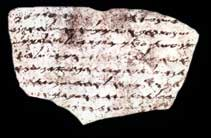
Important light has been revealed regarding the last days of Judah by the discovery in 1935 of eighteen ostraca (clay tablet with writing in ink) written in an ancient cursive script belonging to the seventh century B.C.
They were discovered at Lachish (Tell ed-Duweir) among the ruins of a small guard room just outside the city gate. Then a few years later three inscribed potsherds were also found at the site, and like the others, they contained names and lists from the period just before the fall of Jerusalem in 586 B.C.
Most of the letters were dispatches from a Jewish commander named Hoshaiah who was stationed at an outpost north of Lachish, who apparently was responsible for interpreting the signals from Azekah and Lachish during the time when the:
Jer 34:7 "when the king of Babylon's army fought against Jerusalem and all the cities of Judah that were left, against Lachish and Azekah; for only these fortified cities remained of the cities of Judah."
These final communications which mentioned the political and religious turmoil of the last days of Judah reveal the intensity of this time period and confirm that which was written in the Bible by the prophet Jeremiah.
The Babylonian Chronicles
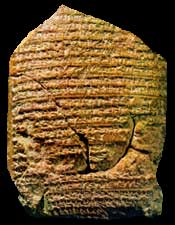
The Babylonian Chronicles make it possible to assign the fall of Jerusalem to the Second of Adar (March 16) in 597 B.C. with complete accuracy, confirming the Biblical accounts of Babylonian attacks on Jerusalem in 597 and 586 B.C.
The Babylonian Chronicle records:
"In the seventh month (of Nebuchadnezzar-599 BC.) in the month Chislev (Nov/Dec) the king of Babylon assembled his army, and after he had invaded the land of Hatti (Syria/Palestine) he laid seige to the city of Judah. On the second day of the month of Adara ( 16th of March) he conquered the city and took the king (Jehoiachin) prisoner. He installed in his place a king (Zedekiah) of his own choice, and after he had received rich tribute, he sent (them) forth to Babylon."
When comparing this text from ancient Babylon with the record of the Babylonian invasion in the Book of II Kings 24:7-17 they demonstrate very clearly the accuracy of the Biblical text.
The Striding Lion
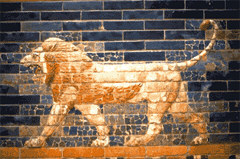
The Striding Lion
Iraq: Babylon, Processional Avenue north of the Ishtar Gate
Neo-Babylonian Period
Reign of Nebuchadnezzar II, ca. 604-562 B.C.
Molded brick with polychrome glaze
90.3 cm H, 230.5 cm W
Purchased in Berlin, 1931
Oriental Institute, Chicago
OIM A7481
This colorful striding lion of glazed brick with its mouth opened in a threatening roar, once decorated a side of the 'Processional Way' in ancient Babylon. The 'Processional Way' led out of the city through a massive gate named for the Mesopotamian goddess of love and war, Ishtar, whose symbol was the lion.
No doubt that any of the Jewish captives that entered Babylon would have seen these lions.
The Ishtar Gate
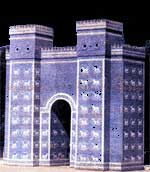
The Ishtar
Gate at Babylon
Reconstruction Glazed Brick
Total Height?47 Feet, Width-32 Feet
Neo-Babylonian
7th?6th Centuries BC
Dedicator: Nebuchadnezzar II
Language: Akkadian
Date of Excavation: 1899-1914
Staatliche Museen , Berlin
Dept. of the Near East
"Is this not Babylon that I have built?" ?Daniel 4:30
The Ishtar Gate, one of the eight gates of the inner city of Babylon, was built during the reign of Nebuchadnezzar II (604- 562 BC). Only the foundations of the gate were found, going down some 45 feet, with molded, unglazed figures. The gateway has been reconstructed in the Pergamon Museum, Berlin, from the glazed bricks found, so its original height is different in size. Reconstructed height is 47 feet.
It was one of the eight gates of the inner city of Babylon. It was built in about 575 BC, the eighth fortified gate in the city. It is one of the most impressive monuments rediscovered in the ancient Near East. The Ishtar gate was decorated with glazed brick reliefs, in tiers, of dragons and young bulls. The gate itself was a double one, and on its south side was a vast antechamber. Through the gatehouse ran a stone-and brick-paved avenue, the so-called Processional Way, which has been traced over a length of more than half a mile.
King Nebuchadnezzar II of Babylon dedicated the great Ishtar Gate to the goddess Ishtar. It was the main entrance into Babylon. King Nebuchadnezzar II performed elaborate building projects in Babylon around 604-562 BC.
The Dedicatory Inscription on the Ishtar Gate reads:
"Nebuchadnezzar, King of Babylon, the faithful prince appointed by the will of Marduk, the highest of princely princes, beloved of Nabu, of prudent counsel, who has learned to embrace wisdom, who fathomed their divine being and reveres their majesty, the untiring governor, who always takes to heart the care of the cult of Esagila and Ezida and is constantly concerned with the well-being of Babylon and Borsippa, the wise, the humble, the caretaker of Esagila and Ezida, the firstborn son of Nabopolassar, the King of Babylon?"
Jehoiakin Inscription
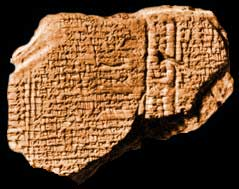
This is one of the clay tablets that reveal the presence of the Judean royal house as prisoners in Babylon. They were excavated from an arched building near the Ishtar Gate of ancient Babylon. The cuneiform texts, which are dated between 595 and 570 B.C., contain lists of rations of barley and oil issued to the captive princes and artisans, including "Yaukin, king of the land of Yahud." This is a direct reference to Jehoiachin, and some of the other tablets also mentioned his 5 sons who accompanied him to Babylon. (Staatliche Museum, Berlin).
Eliakim Seal
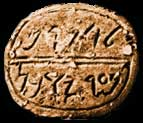
This seal bears the inscription "The property of Eliakim, steward of Jehoiakin." It is from Debir (Tell Beit Mirsim) located 13 miles southwest of Hebron. It was excavated by William F. Albright in 1926.
Gedaliah Seal
This seal was found at Lachish and bears the inscription "Gedaliah, who is over the house." Gedaliah was the name of the man who the Babylonians had appointed as governor of Judah after the destruction of Jerusalem.
Nabonidus Stele
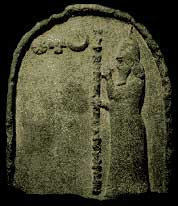
Nabonidus was known to be the king on the throne at the time of the Medo-Persian conquest of Babylon. However, in 1854 archaeologist Sir Henry Rawlinson found an inscription, while excavating at ancient Ur, which stated that Nabonidus associated with him on his throne his eldest son, "Bel-shar-usur", and allowed him the royal title.
Cyrus Cylinder
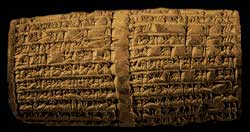
"...I am Cyrus. King of the world. When I entered Babylon...I did not allow anyone to terrorize the land...I kept in view the needs of the people and all its sanctuaries to promote their well-being...I put an end to their misfortune. The Great God has delivered all the lands into my hand; the lands that I have made to dwell in a peaceful habitation..."
On the site of Babylon, archaeologists discovered the Cyrus Cylinder, a clay cylinder with inscriptions which record details about the capture of Babylon by the Persian king Cyrus (539 B.C.).
According to the cuneiform on the Cyrus Cylinder, he was favored by Marduk and the other gods who purposed for Nabonidus and Belshazzar to be dethroned and divine help would be given to Cyrus. Cyrus reestablished their religious practices and was a very benevolent and gracious ruler. He was responsible for the return of the Jews to Jerusalem and the rebuilding of their temple.
Also See:
Read The Bible
- 1599 Geneva Bible (GNV)
- 21st Century King James Version (KJ21)
- American Standard Version (ASV)
- Amplified Bible (AMP)
- Amplified Bible, Classic Edition (AMPC)
- Authorized (King James) Version (AKJV)
- BRG Bible (BRG)
- Christian Standard Bible (CSB)
- Common English Bible (CEB)
- Complete Jewish Bible (CJB)
- Contemporary English Version (CEV)
- Darby Translation (DARBY)
- Disciples’ Literal New Testament (DLNT)
- Douay-Rheims 1899 American Edition (DRA)
- Easy-to-Read Version (ERV)
- English Standard Version (ESV)
- English Standard Version Anglicised (ESVUK)
- Evangelical Heritage Version (EHV)
- Expanded Bible (EXB)
- GOD’S WORD Translation (GW)
- Good News Translation (GNT)
- Holman Christian Standard Bible (HCSB)
- International Children’s Bible (ICB)
- International Standard Version (ISV)
- J.B. Phillips New Testament (PHILLIPS)
- Jubilee Bible 2000 (JUB)
- King James Version (KJV)
- Lexham English Bible (LEB)
- Living Bible (TLB)
- Modern English Version (MEV)
- Mounce Reverse Interlinear New Testament (MOUNCE)
- Names of God Bible (NOG)
- New American Bible (Revised Edition) (NABRE)
- New American Standard Bible (NASB)
- New American Standard Bible 1995 (NASB1995)
- New Catholic Bible (NCB)
- New Century Version (NCV)
- New English Translation (NET)
- New International Reader's Version (NIRV)
- New International Version - UK (NIVUK)
- New International Version (NIV)
- New King James Version (NKJV)
- New Life Version (NLV)
- New Living Translation (NLT)
- New Matthew Bible (NMB)
- New Revised Standard Version (NRSV)
- New Revised Standard Version Catholic Edition (NRSVCE)
- New Revised Standard Version, Anglicised (NRSVA)
- New Revised Standard Version, Anglicised Catholic Edition (NRSVACE)
- New Testament for Everyone (NTE)
- Orthodox Jewish Bible (OJB)
- Revised Geneva Translation (RGT)
- Revised Standard Version (RSV)
- Revised Standard Version Catholic Edition (RSVCE)
- The Message (MSG)
- The Voice (VOICE)
- Tree of Life Version (TLV)
- World English Bible (WEB)
- Worldwide English (New Testament) (WE)
- Wycliffe Bible (WYC)
- Young's Literal Translation (YLT)
Table of Contents
- Introduction
- Overview
- The Destruction of Jerusalem
- The Deportation of Judah
- Seventy Years
- Treatment of the Jews in Babylon
- Benefits of the Babylonian Captivity
- Archaeology and the Babylonian Captivity
- Dictionaries and Encyclopedias
- Timeline of Events
- Scriptures
- Conclusion
- Babylon
- Tel Abib
- Susa
- Ecbatana
- Persepolis
- Pasargadae
Main Menu
- Ancient Assyrian Social Structure
- Ancient Babylonia
- Ancient Canaan During the Time of Joshua
- Ancient History Timeline
- Ancient Oil Lamps
- Antonia Fortress
- Archaeology of Ancient Assyria
- Assyria and Bible Prophecy
- Augustus Caesar
- Background Bible Study
- Bible
- Biblical Geography
- Fallen Empires - Archaeological Discoveries and the Bible
- First Century Jerusalem
- Glossary of Latin Words
- Herod Agrippa I
- Herod Antipas
- Herod the Great
- Herod's Temple
- High Priest's in New Testament Times
- Jewish Literature in New Testament Times
- Library collection
- Map of David's Kingdom
- Map of the Divided Kingdom - Israel and Judah
- Map of the Ministry of Jesus
- Matthew Henry Bible Commentary
- Messianic Prophecy
- Nero Caesar Emperor
- Online Bible Maps
- Paul's First Missionary Journey
- Paul's Second Missionary Journey
- Paul's Third Missionary Journey
- Pontius Pilate
- Questions About the Ancient World
- Tabernacle of Ancient Israel
- Tax Collectors in New Testament Times
- The Babylonian Captivity
- The Black Obelisk of Shalmaneser
- The Books of the New Testament
- The Court of the Gentiles
- The Court of the Women in the Temple
- The Destruction of Israel
- The Fall of Judah with Map
- The History Of Rome
- The Incredible Bible
- The Jewish Calendar in Ancient Hebrew History
- The Life of Jesus in Chronological Order
- The Life of Jesus in Harmony
- The Names of God
- The New Testament
- The Old Testament
- The Passion of the Christ
- The Pharisees
- The Sacred Year of Israel in New Testament Times
- The Samaritans
- The Scribes
Ancient Questions
- Why Do the Huldah Gates Appear Different in Ancient Replicas and Modern Photos?
- What Is the Origin of the Japanese and Chinese Peoples? A Biblical Perspective
- How did the ancient Greeks and Romans practice medicine and treat illnesses?
- What were the major contributions of ancient Babylon to mathematics and astronomy?
- How did the ancient Persians create and administer their vast empire?
- What were the cultural and artistic achievements of ancient India, particularly during the Gupta Empire?
- How did ancient civilizations like the Incas and Aztecs build their remarkable cities and structures?
- What were the major trade routes and trading practices of the ancient world?
- What was the role of slavery in ancient societies like Rome and Greece?
- How did the ancient Mayans develop their sophisticated calendar system?
Bible Study Questions
- Why Do Christians Celebrate Christmas?
- How Many Chapters Are There in the Bible?
- The Five Key Visions in the New Testament
- The 400-Year Prophecy: Unpacking Genesis 15 and the Journey of a People
- The Authorized (King James) Version (AKJV): Historical Significance, Translation Methodology, and Lasting Impact
- Exploring the English Standard Version (ESV): Its Aspects, Comparisons, Impact on Biblical Studies, and Church Use
- A Detailed Historical Analysis of Language Updates in the KJ21: Comparison with Other Versions
- A Detailed Historical Analysis of the American Standard Version (ASV): Comparison to the King James Version, Influence on Later Translations, and Evaluation of Strengths and Weaknesses
- A Detailed Historical Analysis of Amplifications in the Amplified Bible (AMP) and Its Comparison to Other Bible Translations
- Detailed Historical Analysis of the Amplified Bible Classic Edition (AMPC): Examples of Amplifications and Comparative Analysis with Other Bible Translations
About
Welcome to Free Bible: Unearthing the Past, Illuminating the Present! Step into a world where ancient history and biblical narratives intertwine, inviting you to explore the rich tapestry of human civilization.
Discover the captivating stories of forgotten empires, delve into the customs and cultures of our ancestors, and witness the remarkable findings unearthed by dedicated archaeologists.
Immerse yourself in a treasure trove of knowledge, where the past comes alive and illuminates our understanding of the present.
Join us on this extraordinary journey through time, where curiosity is rewarded and ancient mysteries await your exploration.
Recent posts
-

Retail Traders Gain Edge with Quantum AI-Powered Market Insights
In these days’s hastily evolving monetary markets, technology is no longer only a device—it’s a competitive benefit. While institutional traders... -

Quantum AI Sets New Standard in Predictive Trading Accuracy
The monetary international isn't any stranger to change, but few innovations have disrupted conventional buying and selling pretty like synthetic inte... -

AI-Powered Trading Apps See Record Growth Among First-Time Investors
The panorama of investing is changing rapid. What was ruled through skilled investors and large institutions is now beginning up to a brand new genera... -

AI Trading Systems Surpass Human Performance in Real-Time Market Analysis
In the ever-evolving world of finance, pace and precision have become the cornerstones of successful buying and selling. As markets reply right away t... -

From Chaos to Clarity: AI Navigates Volatile Markets with Unmatched Precision
In an generation of global uncertainty, fast economic shifts, and exceptional market volatility, the ability to navigate economic chaos with clarity h...